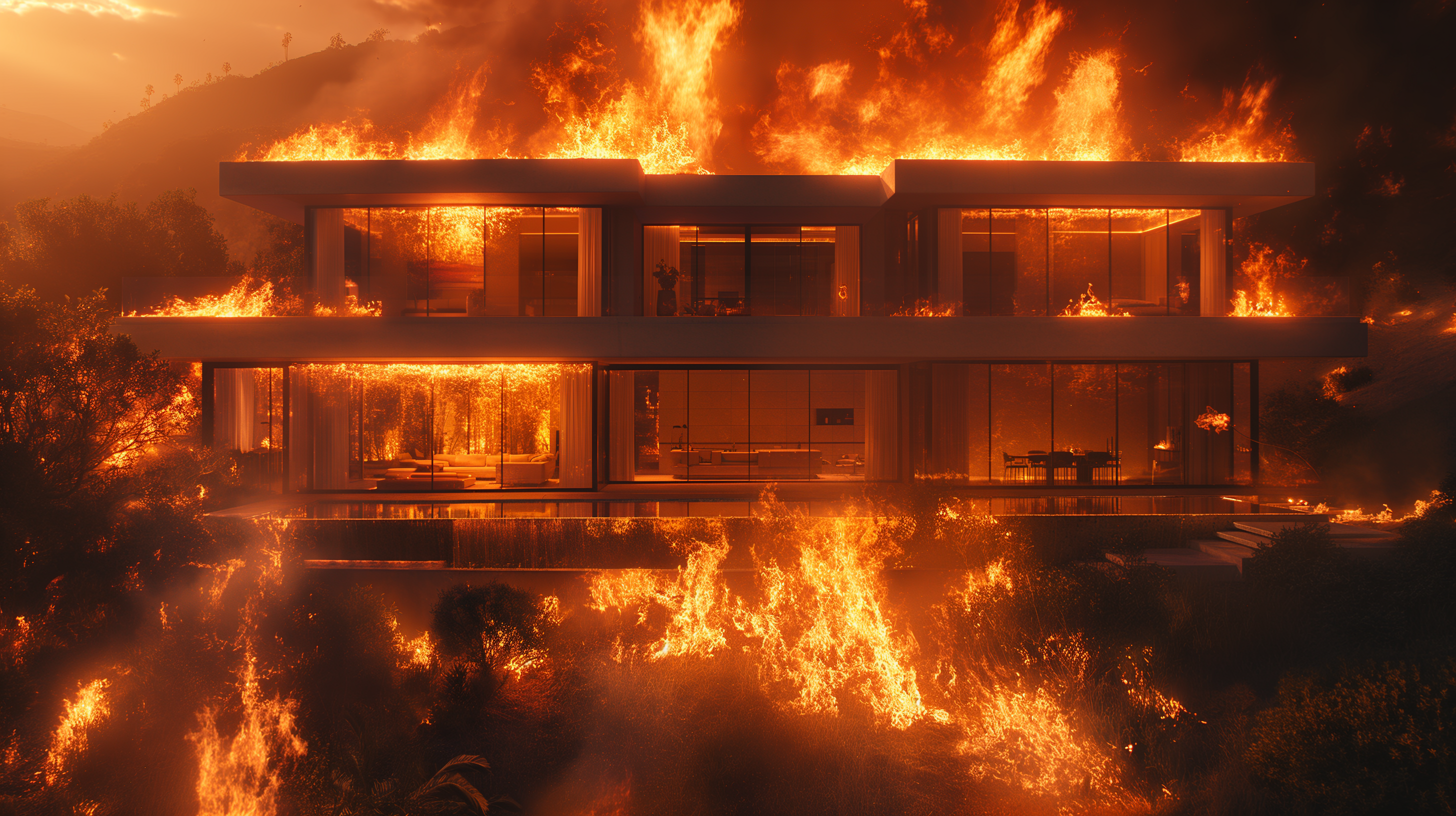
California homeowners are taking on the FAIR Plan in court, challenging restrictive wildfire coverage policies. This legal battle could dramatically impact insurance availability and affordability in fire-prone areas, potentially forcing reforms that expand coverage but increase rates.
by LawInc Staff
July 27, 2024
A class action lawsuit filed in Alameda County Superior Court alleges that the California FAIR Plan Association (CFPA) is improperly restricting insurance coverage for losses caused by wildfires and breaching its duty to provide the basic property insurance required by state law. This guide covers key details of the case, insurance issues, and potential impacts on California homeowners.
From the policy provisions at the heart of the dispute to the statutory and regulatory framework governing the CFPA, get an in-depth look at the key facts, allegations, legal theories, and procedural history you need to understand this consequential insurance coverage battle.
Learn about the named plaintiffs, putative class, and the CFPA’s role in the California insurance marketplace. Explore the alleged misrepresentations to regulators, the Department of Insurance’s market conduct examination findings, and what constitutes bad faith by an insurer. Find out what’s at stake and what a win for the plaintiffs could mean for property owners across the state.
1. Understand the FAIR Plan’s Role & the Insurance Law Involved
-
- What is the California FAIR Plan? The CFP is an insurance industry association that provides basic property insurance to Californians who can’t secure it in the normal market.
- Basic Property Insurance Requirements: By law, CFP policies must cover “perils insured under the standard fire policy” per Ins. Code §10091(c)(1).
- California Standard Form Fire Policy: Ins. Code §2071 sets forth required language and coverages for fire policies issued in the state.
- Extended Coverage & Endorsements: The Standard Form covers “all loss by fire” and allows for additional perils to be added by endorsement.
- Coverage Mandate: According to Ins. Code §2070, fire insurance policies are required to offer coverage that is at least as beneficial to the insured as the Standard Form.
Examples:
-
- Michelle’s home-based business couldn’t get covered in the regular market after devastating wildfires hit her area, so her broker helped her secure a FAIR Plan commercial policy instead.
- The §2071 Standard Form requires coverage of “all LOSS BY FIRE, LIGHTNING, AND BY REMOVAL FROM PREMISES ENDANGERED BY THE PERILS INSURED AGAINST IN THIS POLICY.”
- Most carriers use the Standard Form as a starting point, then add additional covered causes of loss by endorsement, but the core fire coverages stay intact.
- When Daniel’s insurer’s fire coverage seemed to fall short of the statutory minimums, his lawyer argued the policy was illegal and unenforceable under §2070.
Key Takeaways:
-
- The FAIR Plan exists to be an insurer of last resort, providing a critical safety net for Californians who can’t get basic property coverage elsewhere.
- FAIR Plan policies are not exempt from the minimum fire coverage requirements set forth in the Insurance Code – they must comply with the Standard Form.
- Any fire coverage that is less favorable to insureds than the Standard Form language faces a strong argument that it’s illegal under CA law.
- For any portion of a loss caused by fire, the Standard Form requires coverage for “all loss”, not just certain types or amounts of fire damage.
- If the FAIR Plan’s policy forms restrict any fire coverage required by §2071, they likely violate the “substantially equivalent” mandate of §2070.
FAQs:
-
- Is the FAIR Plan funded by taxpayers? No, it’s entirely funded by the private insurers who are required to participate as a condition of selling property insurance in California.
- How many Californians are covered by the FAIR Plan? The number fluctuates but has increased greatly in recent years, with the FAIR Plan now writing fire policies for well over 350,000 homes statewide.
- Why would a policy provide less coverage than the Standard Form? Insurers may try to limit their risk or exposure by narrowing or excluding certain types or amounts of fire damage in their policies.
- What happens if a policy violates the Insurance Code? The unlawful provisions are unenforceable and the policy will typically be reformed by the court to match the statutory minimum coverage.
- Who decides substantial equivalence? Ultimately a judge would decide if challenged, with input from the Department of Insurance and insurance law experts.
2. Dive Into the Plaintiffs’ Claims & Class Allegations
-
- Named Plaintiffs: This case is brought by Amanda Arteno, Patricia Martinez, James Talbot, and Kevin Tam – all CFPA policyholders.
- Bad Faith Allegations: Plaintiffs allege CFPA acted in bad faith by unreasonably restricting coverage for wildfire losses through policy exclusions and sub-limits.
- Direct Physical Loss Definition: CFPA policies limit coverage to “direct physical loss…evidenced by permanent physical changes” to insured property.
- Smoke Damage Restrictions: CFPA policies only cover wildfire smoke damage that is visible to the naked eye or nose, expressly excluding forensic or test-detected damage.
- Putative Class: Plaintiffs seek to represent all current CFPA policyholders with policies containing the challenged “direct physical loss” and “smoke damage” clauses.
Examples:
-
- Testing detected soot, char and ash in Amanda’s attic after a wildfire, but CFPA declined to pay for cleaning since the particles weren’t visible to the naked eye.
- Kevin submitted a lab report showing toxic wildfire contaminants on his property, but CFPA said those forensic findings weren’t covered under his policy.
- Patricia lost rental income for months after a fire, but CFPA capped her fair rental value benefits based on the policy’s restrictive “direct physical loss” definition.
- Tens of thousands of California FAIR Plan policyholders could potentially recover unpaid wildfire benefits if the plaintiffs’class is certified by the court.
Key Takeaways:
-
- Plaintiffs allege CFPA’s coverage restrictions & exclusions for wildfire losses are inconsistent with California’s statutory fire insurance requirements.
- Limiting coverage to “direct physical loss” evidenced by “permanent physical changes” arguably conflicts with the “all loss by fire” mandate in §2071.
- Covering only smoke damage visible to an “unaided human eye” ignores how dangerous wildfire contaminants can be microscopic yet still cause covered loss.
- The class action seeks a ruling that CFPA policies violate the law and injunction requiring reforms to match the Standard Form’s minimum coverage.
- A victory could entitle class members to expanded coverage applying retroactively to all open claims, leading to potentially massive additional payments.
FAQs:
-
- Why sue the FAIR Plan rather than the legislature or a private insurer? The FAIR Plan is required by law to provide the coverage written into the Insurance Code, so a successful case enforces existing law.
- What’s the legal standard for a policy clause to be declared illegal? Provisions that are contrary to the requirements of the Insurance Code or attempt to waive unwaivable statutory rights are unenforceable in court.
- How challenging is it to certify a class action in this type of case? Certification standards are complex, but the key factors are whether common legal & factual issues predominate among a numerous group that’s ascertainable.
- What does “putative” class mean? It means the group is not yet formally certified by the court to proceed as a class, but is proposed as a potential class action at the initial stages.
- How long does a class action like this typically take to resolve? Large insurance class actions can take 2-5 years to reach trial or settlement, depending on the scope of discovery, motions, and appeals.
3. Examine CFPA’s Alleged Statutory & Regulatory Violations
-
- Insurance Code §2070: Prohibits issuing a fire policy that is less favorable to the insured than the coverage provided by the Standard Form in §2071.
- Standard Form Coverage of “All Loss By Fire”: The Standard Form expressly insures against “all loss by fire”, not just fire damage evidenced by permanent physical changes.
- Standard Form Silence on Smoke Damage: The Standard Form has no exclusions or sub-limits for smoke damage, meaning insureds get full smoke loss coverage.
- Alleged Misrepresentations to CDI: Lawsuit claims CFPA falsely told Department of Insurance its 2017 policy changes would not reduce coverage.
- DOI Legal Opinions & Directives: The DOI has opined CFPA’s policies violate law and ordered the FAIR Plan to remove unlawful provisions & restrictions.
Examples:
-
- When Kevin’s home was inundated with toxic smoke in a wildfire, CFPA refused to pay for decontamination since the Standard Form doesn’t expressly address smoke.
- Maria’s CFPA-insured restaurant continued to smell like smoke after it was cleaned, but CFPA denied further payments saying the residual odor wasn’t a “directphysical loss”.
- CFPA told the DOI its 2017 policy revisions “will either provide no change in coverage or will provide some broadening of coverage”, but later informed insureds the changes “may be viewed as reducing or limiting coverage.”
- In 2021, the DOI general counsel wrote to CFPA that its policy restrictions on smoke damage are “contrary to the law” and demanded the provisions be reformed to match the Standard Form.
Key Takeaways:
-
- The lawsuit alleges CFPA’s policy language defining “direct physical loss” & “smoke damage” violates the Insurance Code’s minimum coverage requirements.
- By covering only fire damage causing “permanent physical changes”, CFPA appears to cover less than the unqualified “all loss by fire” mandated in §2071.
- Since the Standard Form doesn’t exclude or limit smoke damage, CFPA’s visible/olfactory smoke restrictions arguably make its policies less favorable to insureds.
- Plaintiffs contend CFPA got its policies approved by the DOI under false pretenses by saying the revisions wouldn’t reduce coverage when they clearly do.
- The DOI itself has found CFPA out of compliance with the Insurance Code, supporting plaintiffs’ position that the challenged policies are illegal.
FAQs:
-
- Does DOI approval of CFPA’s policies mean they comply with the law? Not necessarily – the DOI can rescind approval if it finds policies violate the Insurance Code, as it did here after further review.
- Why were these policy provisions approved by the DOI if they’re illegal? Plaintiffs allege CFPA obtained approval through misrepresentations about the provisions’ impact on coverage.
- Can insurers contract around the Standard Form’s required coverages? No – any policy provisions that attempt to waive or reduce the minimum statutory coverages would be void against public policy.
- Have courts upheld the Insurance Code’s fire coverage mandates before? Yes – CA courts consistently rule that policies with less favorable fire terms than the Standard Form violate §2070 & §2071.
- What happens if CFPA refuses to comply with the DOI directives? The DOI can sue to enforce its legal positions, disqualify CFPA from operating, or impose fines & penalties for noncompliance.
4. Unpack the DOI’s Market Conduct Exam Findings
-
- Exam Purpose & Scope: The DOI conducted a market conduct exam to investigate complaints about CFPA’s handling of wildfire smoke damage claims.
- Review Period & Sample Size: Examiners reviewed 259 randomly selected CFPA claim files closed between 2017-2021 across several fire perils & coverages.
- Key Findings of Violations: The exam concluded CFPA does not provide coverage substantially equivalent to the Standard Form required by §2070.
- Failure to Cover All Loss by Fire: Examiners found CFPA’s policies improperly restrict fire coverage by imposing a more stringent “direct physical loss” standard.
- Misrepresentations to Regulators: The report states CFPA misled the DOI about the impact of its policy changes when seeking approval, falsely saying coverage wouldn’t be reduced.
Examples:
-
- The exam found 59 instances where CFPA failed to provide coverage at least as favorable as the Standard Form, in violation of §2070.
- Examiners cited 59 examples of CFPA improperly denying or limiting claims by relying on the “permanent physical changes” and visible/detectable smoke damage restrictions.
- The report excerpts the exact statements CFPA made to the DOI in 2016 asserting the planned policy revisions “will not reduce or eliminate existing coverages.”
- But examiners found CFPA sent policyholders a notice in 2017 directly contradicting that, admitting the policy changes “in some circumstances…has been a reduction of limits and elimination of coverage.”
Key Takeaways:
-
- The market conduct exam provides strong evidence supporting the plaintiffs’ core contentions about CFPA’s statutory violations & misrepresentations.
- With a large random sample of actual CFPA claim files, examiners were able to identify dozens of examples of the alleged illegal coverage restrictions in action.
- Crucially, the exam independently concludes that CFPA’s policies do not comply with the “all loss” & “substantially equivalent” coverage mandates in §2070 & §2071.
- The report also substantiates the allegations that CFPA made false statements to regulators about the impact of its policy changes to obtain approval.
- These findings carry great weight coming from the DOI’s own examiners and add significant credibility and validation to the plaintiffs’ legal theories.
FAQs:
-
- What is a market conduct examination? It’s a formal review done by the DOI’s examiners to assess an insurer’s compliance with insurance statutes, regulations & policy provisions.
- How often does the DOI examine the FAIR Plan? The DOI has discretion to conduct exams as needed – the last prior exam of CFPA was in 2016 before the policy changes at issue.
- Are insurers required to cooperate with market conduct exams? Yes – the Insurance Code gives the DOI broad authority to investigate insurers & compel production of records.
- Does a final exam report create any binding legal obligations? Typically the DOI will issue instructions to insurers to address violations, which they can enforce via administrative actions.
- Can the exam findings be used as evidence in the class action? Yes – plaintiffs will likely seek to admit the report as strong proof supporting their claims from an expert government agency.
5. Analyze CFPA’s Defenses & Counterarguments
-
- Policies Approved by DOI: CFPA argues its policies are lawful because they were approved by the Department of Insurance, which is tasked with enforcing the Insurance Code.
- No Affirmative Reduction in Coverage: The FAIR Plan contends its policy revisions didn’t actively slash existing coverage, just clarified and defined key terms.
- Requests to Dismiss: CFPA will likely attack the legal sufficiency of the complaint and ask the court to dismiss the case for failure to state valid claims.
- Challenge to Class Certification: Expect the FAIR Plan to argue against class certification by claiming individual issues predominate over common ones.
- Filed Rate Doctrine: CFPA may assert that the lawsuit improperly seeks to challenge approved insurance rates, in violation of the “filed rate doctrine.”
Hypotheticals:
-
- In its response to the complaint, CFPA emphasized that the DOI formally approved the policies in question after a full review in 2017.
- CFPA’s CEO published an op-ed arguing the policy changes were just clarifications to make coverage determinations more objective & consistent.
- In its first court filing, CFPA moved to dismiss the case arguing plaintiffs’ theories are legally unsupported and the Insurance Code allows CFPA’s policy language.
- CFPA has signaled it will oppose class cert on the basis that each policyholder’s claim requires individualized assessment of the specific fire, property & damages involved.
Key Takeaways:
-
- While CFPA has some surface-appealing arguments, most of its defenses face an uphill battle against the strong statutory language and DOI findings.
- The prior approval of policy forms is not conclusive because the DOI can withdraw approval if it later determines the forms are unlawful, as it did here.
- Putting labels like “clarification” on the policy changes doesn’t change their actual impact of providing less favorable coverage than the Standard Form requires.
- Plaintiffs only need to show some reasonable basis for their legal theories to overcome dismissal, and the court will likely find the DOI’s positions meet that bar.
- The class certification fight will be fact-intensive, but the uniformity of the policy language and statutory issues support finding predominance.
FAQs:
-
-
- Can the DOI really just change its mind on the legality of policies after approving them? Yes – the Insurance Code allows the DOI to revoke approval if it determines policies don’t meet legal requirements.
- How much emphasis will the court give to the DOI’s conclusions? Courts give significant weight to agencies’ reasonable interpretations of statutes in their jurisdiction, but judges can disagree.
- What’s the legal standard for a motion to dismiss? The court assumes the plaintiffs’ factual allegations are true and decides whether they plausibly state a valid legal claim.
- What does “predominance” mean for class certification? Plaintiffs must show the main factual & legal issues are common to the whole class and more significant than individualized issues.
- Will policyholders have a chance to opt out of the class? Almost certainly yes – the rules provide a mandatory opt-out right in class actions for money damages.
-
6. Understand What’s At Stake for Policyholders & the Industry
-
- Potential for Massive Damages: With 350,000+ policyholders in the putative class, the aggregate unpaid & underpaid wildfire claims could be enormous.
- Increased Claims & Losses for FAIR Plan: If CFPA has to cover previously denied perils like invisible smoke damage, its covered losses & payouts will rise substantially.
- More Policies Shifted to FAIR Plan: Requiring CFPA to cover more wildfire losses could make private insurers even less willing to write in high-risk areas.
- Potential Insolvency or Assessments: If the ultimate liability is high enough, CFPA could face insolvency or have to assess participating insurers to fund a shortfall.
- Pressure on DOI to Raise FAIR Plan Rates: Expanded coverage will likely lead CFPA to seek substantial rate increases, putting the DOI in a political bind.
Examples:
-
- If each of the 350,000 CFPA policyholders had just $5,000 in improperly denied smoke damage, the additional covered losses would exceed $1 billion.
- The Oakland Hills Fire generated over $1.5 billion in losses for the FAIR Plan from just 437 homes – the 2017 Tubbs Fire destroyed nearly 6,000 structures.
- After the 2018 Camp Fire, CFPA policies in the impacted counties surged as much as 400% as admitted insurers dropped coverage.
- Major wildfires in 2017 & 2018 drained CFPA’s reserves, and another $1 billion loss could require emergency assessments & threaten its ability to operate.
Key Takeaways:
-
- The outcome of this case could reshape the insurance market for the 4.5 million California homes in wildfire-prone areas.
- A plaintiffs’ win would provide a huge boon to CFPA policyholders by expanding coverage for previously excluded wildfire losses like smoke damage.
- But that would come at a steep cost to the FAIR Plan and likely policyholders too – the increased losses would necessitate dramatic rate hikes.
- If more policies get pushed into the FAIR Plan as a result, that reduces choice and competition for consumers in the already strained admitted market.
- There could be ripple effects on the overall California economy too, as home values, development, and lending are all impacted by insurance availability & cost.
FAQs:
-
- How much could a class member receive if the case settles? It’s too early to say, but the per-policyholder number is unlikely to be huge – the significance is more in the aggregate and go-forward impact.
- Would a loss bankrupt the FAIR Plan? Not necessarily, but it could require assessing participating insurers or even using state backstop funds like the Wildfire Fund.
- How high could CFPA rates go if it has to cover more wildfire losses? That depends on how much additional losses there are, but likely double-digit increases to make up the shortfall.
- Will a plaintiffs’ win mean more policies in the voluntary market? Unlikely – it will probably drive more insurers to reduce writings in wildfire-prone areas since the FAIR Plan is even riskier.
- What if an insurer refuses to pay CFPA assessments? The DOI can suspend or revoke their certificate of authority to operate in California for noncompliance.
Summary

The outcome of this case against the California FAIR Plan could have major repercussions for insurance coverage, availability & affordability for millions of Californians in wildfire-prone regions.
The class action lawsuit against the FAIR Plan raises critical questions about the scope of fire insurance coverage required by California law and the plan’s role as an insurer of last resort. With allegations of improper coverage restrictions and misrepresentations to regulators, the case puts a spotlight on the state’s approach to insuring homes in high wildfire risk areas.
At stake are potentially billions in insurance payouts for California wildfire victims, the solvency of the FAIR Plan, and the health of the state’s overall property insurance market. A win for the policyholders would expand access to coverage but likely drive up rates, while a FAIR Plan victory preserves its ability to limit its risk but leaves many wildfire losses uninsured.
Regardless of the outcome, this case is a wake-up call that California’s current model for insuring wildfire risk is broken and in need of reform. Policymakers, insurers, and consumers must come together to forge a more sustainable approach balancing the needs for available, affordable, and adequate coverage.
Test Your FAIR Plan Lawsuit Knowledge
Questions: Insurance Law & Policy Fundamentals
-
- 1. What types of coverage is the California FAIR Plan required to offer by law?
- A) Liability only
- B) Fire and wildfire coverage
- C) “Basic property insurance”
- D) Whatever the insurance commissioner mandates
- 2. What perils are included in the definition of “basic property insurance”?
- A) Aircraft and vehicle damage
- B) Perils covered per the standard fire policy
- C) Earthquake and flood
- D) All natural disasters and weather events
- 3. How much does the California standard form fire policy cover?
- A) Up to the policy limit
- B) Only direct damage from flames
- C) “All loss by fire”
- D) A “reasonable” amount determined by the insurer
- 4. Can fire policies deviate from the California standard form coverages?
- A) Yes, as long as they get approval from the FAIR Plan
- B) No, any differences are illegal under the Insurance Code
- C) Only if the deviations provide more favorable coverage
- D) If the insurer files the changes and the DOI doesn’t reject them
- 5. What does it mean for a policy to provide “substantially equivalent” coverage to the standard form?
- A) It must match the standard form word-for-word
- B) It has to cover at least 80% of the same perils
- C) Coverage must be at least as favorable to the policyholder.
- D) It’s up to the insurance company to determine equivalence
- 1. What types of coverage is the California FAIR Plan required to offer by law?
Answers: Insurance Law & Policy Fundamentals
-
- 1. C) The FAIR Plan is required by Insurance Code 10091(c) to offer “basic property insurance” to Californians who can’t obtain it in the normal market.
- 2. B) Section 10091(c) Defines “basic property insurance” to include perils covered by the California standard fire insurance policy.
- 3. C) The California standard form fire policy, as detailed in Insurance Code §2071, requires coverage for “all loss by fire.”
- 4. C) Under Insurance Code 2070, insurers can only deviate from the standard form if the coverage provided is at least as favorable to policyholders.
- 5. C) Section 2070 allows fire policies to vary from the standard form if coverage is “substantially equivalent to or more favorable to the insured.”
Questions: Lawsuit Allegations & Proceedings
-
- 1. What FAIR Plan policy language do the plaintiffs allege violates the Insurance Code?
- A) The definition of “basic property insurance”
- B) The exclusion for “intentional acts”
- C) The sub-limits on additional living expenses
- D) The definitions of “direct physical loss” and “smoke damage”
- 2. How do the plaintiffs allege the FAIR Plan misled regulators?
- A) By falsely claiming the policy was identical to the statutory standard form
- B) By omitting any mention of coverage restrictions when seeking approval
- C) By stating the policy changes would not reduce coverage
- D) By backdating the coverage limitations to avoid regulatory review
- 3. What do the plaintiffs seek to represent in the lawsuit?
- A) All Californians in counties with high wildfire risk
- B) All FAIR Plan policyholders with smoke damage claims
- C) All FAIR Plan policyholders with the problematic policy language
- D) All property insurance policyholders in California
- 4. What does the Department of Insurance allege in its market conduct exam report?
- A) That the FAIR Plan engaged in unfair claims settlement practices
- B) That the FAIR Plan unlawfully discriminated in underwriting
- C) That the FAIR Plan failed to cover all loss by fire as required by law
- D) That the FAIR Plan charged excessive and unfairly discriminatory rates
- 5. What is the legal standard for a motion to dismiss in a class action?
- A) Whether the alleged facts, if true, state a plausible legal claim
- B) Whether plaintiffs proved case by a preponderance of evidence
- C) Whether plaintiffs are likely to succeed on merits at trial
- D) Whether plaintiffs have exhausted all administrative remedies with the DOI
- 1. What FAIR Plan policy language do the plaintiffs allege violates the Insurance Code?
Answers: Lawsuit Allegations & Proceedings
-
- 1. D) The complaint specifically challenges the FAIR Plan’s policy definitions of “direct physical loss” to require permanent physical changes and “smoke damage” to be visible/detectable.
- 2. C) Plaintiffs allege the FAIR Plan falsely assured the DOI that the 2017 policy revisions would “not reduce or eliminate existing coverages” to obtain approval.
- 3. C) The proposed class includes all FAIR Plan policyholders who currently have policies with the allegedly unlawful definitions of “direct physical loss” and “smoke damage”.
- 4. C) The DOI’s 2021 market conduct exam concluded the FAIR Plan failed to cover all loss by fire as required by the Insurance Code through its restrictive policy language.
- 5. A) On a motion to dismiss, the court presumes the plaintiffs’ factual claims are true and assesses whether they present a plausible legal claim, without considering evidence.
Disclaimer
The information in this article discussing the class action lawsuit against the California FAIR Plan Association is provided for general educational purposes only and does not constitute formal legal advice. The laws, allegations and proceedings described are subject to change.
For specific legal guidance on insurance matters, please consult an experienced attorney. Many law firms provide free consultations to review individual cases and discuss available options. Policyholders should not rely on this general overview as a substitute for independent legal advice based on the unique facts of their claim and policy.
Need Legal Help?
If you need legal assistance, in any field of law, our free concierge service can connect you with experienced attorneys in any practice area and state. Contact us to learn more.
Also See
Classroom Confidential: Inside the Explosive Lawsuit Challenging California’s AB 1955
Troubled Waters: Inside the Landmark Pollution Case Against the Port of LA










